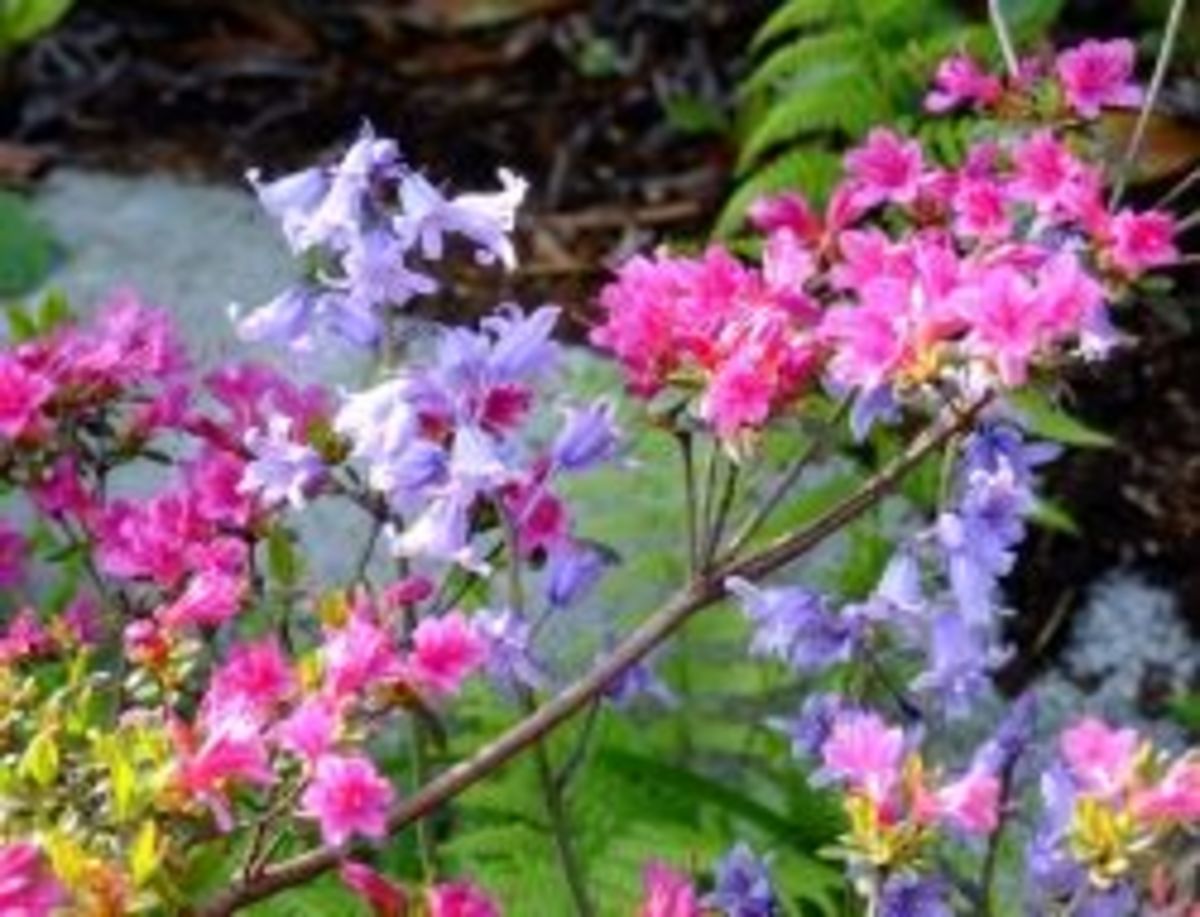6 Money Saving Gardening Tips
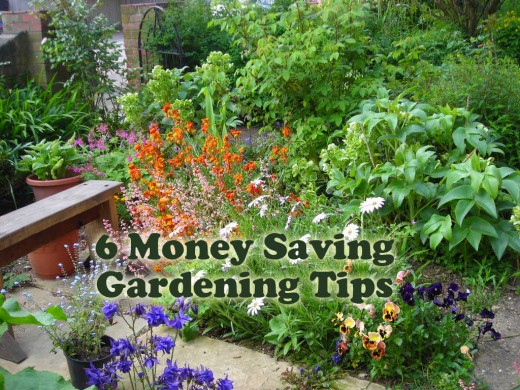
Tips for Gardening on a Shoestring - Money Saving Ideas
Gardening can be a very expensive hobby. This can be a bit daunting if you haven't got a lot of money to spend, and you may have other priorities. This article is going to show you how you can have a beautiful garden without spending much money.
The money-saving gardening tips on this web page should save you about £70 ($100) - a (modest) fortune.
As there are 17 Tips altogether, I have broken my article up into 3 separate web pages, so that you can digest a bit of the information at a time, and save it to refer to later. I have used all these ideas myself for my own garden, and all the photographs show my own garden in London.
To Summarise, Here is a Quick Run-Down of Seventeen Money-Saving Garden Tips
The full list is here, as a reminder of all seventeen cost-effective gardening tips, and below this list is a more detailed description about the first six items. There are then links to the next items which are on a separate page.
- Use Plastic Bottles as Cloches to Protect against Weather and Predators
- Use Small Plastic Pots with Lids as Slug Traps for your Garden
- Collect Slugs and Snails by Hand
- Use Plastic boxes and containers as seed trays
- Make Your Own Stakes for the Garden
- Don't always Buy Your Plants from Nurseries
- Gather Seeds or Seed Heads from Your Own Plants
- Use large pie tins, such as Fray Bentos Steak and Kidney Pie as Plant Saucers
- Improvise with unwanted furnishings as Plant Racks
- Get free Plastic Pots and Gardening Implements from Freecycle - Lots of people give these things away
- Join Seedswop or start a plant and cutting exchange yourself
- Learn How to Take Cuttings of Plants and other Propagation Methods
- Re-Use Plant Pots and Plant Ties
- Make a Vegetable Plot
- Make use of Unusual Containers for Container Gardening
- If your Garden Backs on to Vacant Land, Use Both Sides of the Boundary Fence
- Use Logs for Garden Seating and Dividers
Use the Above List of Penny-Wise Hints For Your Garden as a Reminder
They are really simple tips, using every-day articles you have around the home.
However, to see more detail about these gardening tips, including photographs:
Tips 1 - 6 are on this page
Tips 7 - 12 are in Money Saving Gardening Tips - Part 2
and Tips 13 - 17 in More Money Saving Tips
1. Use Plastic Bottles as Cloches to Protect Against Weather and Predators
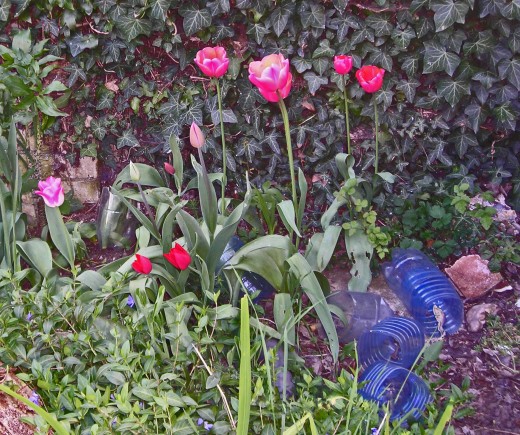
To Make Your Own Weatherproof Cloches:
Take a 1-litre or 2-litre plastic bottle or milk container.
Cut it in half horizontally, using scissors or a sharp knife, taking care not to cut yourself as the plastic surfaces are slippery. You then have two different styles of Cloche:
1) The top end: The pouring end lets in the air (and water), and the base goes firmly into the earth.
2) The base: The base end of the bottle forms a cloche which does not let in air and water when placed over the plant. You may choose to cut off the base, so that you have a cloche which is open at both ends, but the covered cloche is more protective in bad weather, and also more efficient in protecting against birds, slugs and snails and other predators.
If your plants are tied to stakes, you might find it more convenient to cut up the side of the bottle/cloche as well, so that you can wrap and unwrap it around plant and stake at the same time.
Remove the cloches when the threat of cold weather ceases, or when the plants get too big for the cloche.
2. Use Small Plastic Pots With Lids as Slug Traps for Your Garden
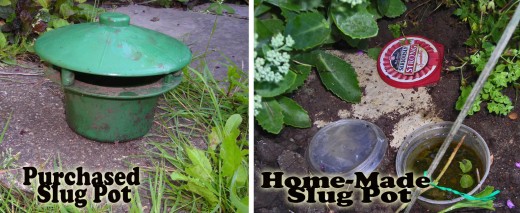
It's easy to make Slug Traps instead of buying them
To make a slug trap, you need a small plastic pot with a lid, for instance a small yogurt pot, or the sort of pot which contains hoummus and dips.
Dig a hole where the slugs are, near the plants you want to protect. The hole should be the size of the pot, so that you can sink the pot in the hole up to the rim.
Prop the lid open with a stone or matchsticks, so that it is closed at one edge and just partly open at the other side. This enables the slugs to climb in easily.
Pour about 1-inch of beer into the bottom of the plastic pot. Slugs and snails love the smell of beer, and queue up to slither in and drink. The theory is that they drown drunk and happy, because they can drop in, but can't climb out.
Savings for four slug pots - about £16 ($18)
3. Save on Slug Bait - Collect Slugs and Snails by Hand
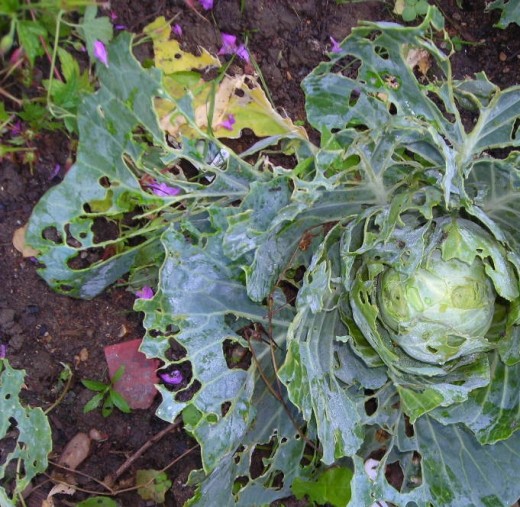
There's No Need to Buy Slug Bait When You Can Just Collect Slugs and Snails by Hand
Well not exactly by hand - use an implement!
Slug bait is all very well, but if you have pets or want to protect wildlife, it is not completely safe for animals.
This gardening tip is not for the faint-hearted, or those who believe that we should not wantonly kill or harm other species (it's apparently OK to kill or harm our own species, though!).
But the picture above is my justification for carrying out war on slugs!
Firstly - Collect the Slugs:
The best method of all is to go round the garden at dusk or dawn, particularly if the garden is damp, collecting the slugs and snails with a trowel and putting them in a plastic container, or a tin. If you start doing this regularly early in the year, you should be able to catch them before they lay eggs. But if, like me, you do it sporadically, you will still come up with even richer pickings - on a warm summer's morning last week I collected about 50 big fat slugs, about half a pound in weight.
If you can find an old and unwanted fork amidst your cutlery, you could use it instead of a trowel to pick up the little marauders - I have just discovered that it is much easier.
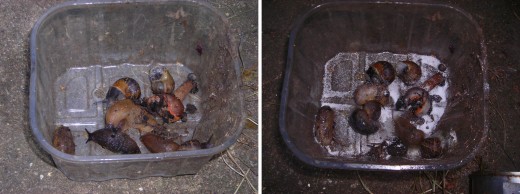
Secondly - To Kill the Slugs:
Put the slug-filled container on the ground, sprinkle very liberally with salt, add about a mug of water, and this will kill them pretty quickly. If any try to escape, just push them back with the trowel.
If you want to be more environmentally friendly, and your garden is adjacent to an open space, just dispose of them in an area where they will be found and eaten by birds and hedgehogs. Slugs and snails have a homing instinct, and tend to return to the area where they live, so you will need to throw them quite far away to prevent them coming back.
Thirdly - To Dispose of the Corpses:
Put the container with the salt water right way up into a plastic bag in which you have pierced holes, so that it acts like a strainer; then hold it over a drain, and tip it up so that the water is poured out through the plastic bag and you are left with a plastic bag full of yukkies, which you wrap up and chuck in the dustbin, asap.
N.B. If you have used slug pellets or salt you should not throw them in with your garden compost or recycling, due to contamination which could harm wildlife.
4. Use Plastic Boxes and Containers as Seed Trays
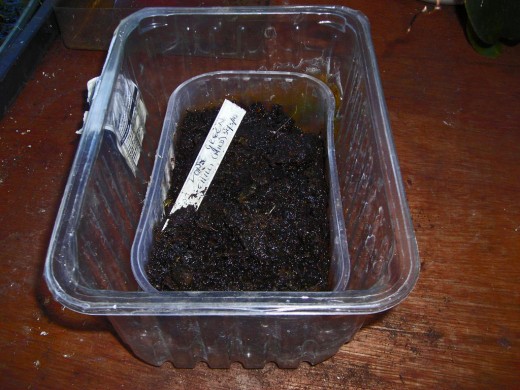
You Don't Need to Buy Seed Trays--Indeed These Slightly Smaller Alternatives to Seed Trays Are Easier to Keep on Window Sills or in Odd Corners
Use small plastic containers, you know, the ones that you get from the supermarket filled with strawberries and other perishable food. Some will have holes in the bottom, and some not.
Put earth or potting compost in the smaller containers which do have holes in them (good for drainage). Use the larger containers without holes as a base for the smaller containers to stand in. So you then have the smaller seed trays with holes draining into the larger ones, so that the plants don't get waterlogged and your shelves don't get soaked.
If necessary, you can make holes in the smaller containers by poking a nail or any pointed implement through the base.
if you get containers with lids as well, so much the better - you then have your own micro climate in which to start off your new seeds. When they have sprouted and leaves appear, remove the lid and grow them on until they are large enough to plant out. If you don't have lids, you can wrap them in polythene bags to stop the water evaporating, or even put polythene wrap round them, but make sure to remove this before the seedlings touch the top, as this would inhibit their growth.
Improvisation is the Name of the Game!
Get into the mindset of not spending any money on the garden unless you have to
5. Make Your Own Wooden Stakes for the Garden
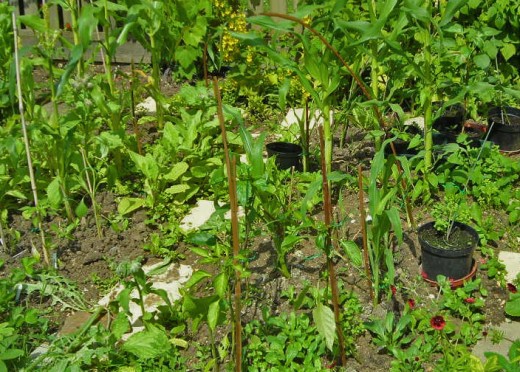
You Don't Need to Buy Bamboo Stakes
Whenever you cut down woody stems like phlox and anemone japonica, save them in a bag to use as short stakes. And you can strip down willow branches and any straightish branches to make long stakes.
Even forked branches make good stakes - you can either put both bits of the fork in the ground and train plants like sweet peas to grow up them onto a single central stake, or you can put the single part in the ground, and train plants to grow up the fork (handy for grape vines and anything that you want to fan out, like clematis and jasmine).
More Stakes Cut From Trees
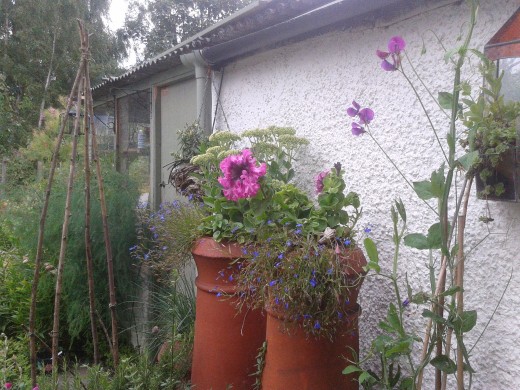
The chimney pots shown above were builders' waste, both free of charge, but very ornamental and making a good focal point as plant containers
6. Don't Always Buy Your Plants From Nurseries

You Can Get Plants from Car Boot Sales, Charity Fairs, Agricultural and Horticultural Shows and School Fairs
Car Boot Sales, Shows and Fairs nearly always have a plant stall, and, provided you examine the plants first to ensure that they are good, you can get plants at half the cost of the ones at Plant Nurseries.
And towards the end of the event, no-one wants to take plants home, they would rather sell them for whatever they can get, or simply get rid of them, so you can buy some really good bargains, or even get them free.
To Avoid Loss, Be Sure to Place Plants in the Right Situation
Before planting, check what conditions they need - if you get it wrong, they won't thrive
Essential Gardening Equipment for the Garden: Gardena Tools Are Good Quality And Will Give You Years of Use

Here's My Own Gardena Weeder Which is About 6 Years Old
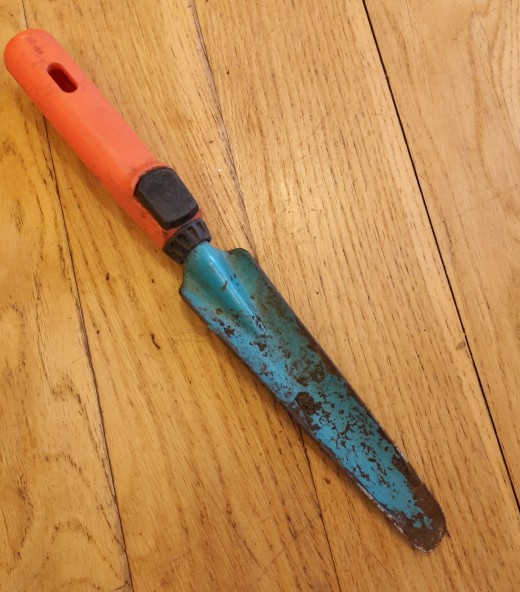
5 Tips to Help Beginner Gardeners Grow More Food in a Small Garden
This content is accurate and true to the best of the author’s knowledge and is not meant to substitute for formal and individualized advice from a qualified professional.





